Signature Dishes of Vietnam That Should Not Be Missed
Vietnam: The Promised Land Of Cuisine For Tourists
Vietnam is a place where nature and people blend in harmony to create a unique beauty and freshness in Vietnamese cuisine. Vietnamese culinary culture is vibrant and abundant because each region has its own outstanding gastronomy which highlights their personality, culture, and customs.
Through the eyes of friendly foreigners, Vietnam is known as the paradise of foods. There are several reasons why Vietnamese cuisine is very famous around the world. Each dish has its own strengths, which are a harmony of colors and flavors, pleasing any diners for the very first time. Here are some of the most attractive cuisines you should not miss out on when visiting Vietnam.
1. Com (young green rice)
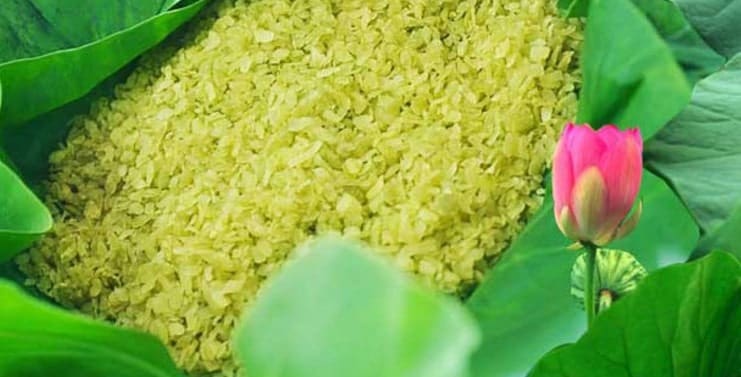
(by: vietnamnet.vn)
For Vietnamese people, Com is a pleasant treasure of the autumn. The green and soft young rice is wrapped in a lotus leaf and tied with a small straw. The best Com is in mid-Autumn, the right time when the rice is young enough. Com is regarded as an identity of Hanoi, called “flavour of heavens”.
Ten days before harvest, Vietnamese people collect their young rice. It is the golden time to collect rice when it is neither too green nor too ripe. They bring the rice home then fry and pound until it becomes soft. Coming to Vietnam villages at that time, you can feel the sweet scent in the air and the lovely sound of rice-pounding.
Com is wrapped in the pure and shiny lotus leaves and tied with straws. Strangely, Vietnamese never use a bowl or a spoon to eat Com, but they use their hands to pick up every small bunches of Com from the lotus leaves. They enjoy Com very slowly to let the sweetness flow to their hearts, and the flavor lingers on their tongues.
Moreover, Com must be eaten with ripe persimmons or bananas. Otherwise, you can enjoy Com with lotus tea. Eating Com is very sophisticated but elegant. With milk flowers and green rice, Com is something you shouldn’t miss in Hanoi autumn.
2. Banh mi (Vietnamese bread)
Banh mi is not a delicacy, but it is a highlight in Vietnamese culture, a snack that goes with any Vietnamese generation. However, Banh mi is highly appreciated by many international friends.
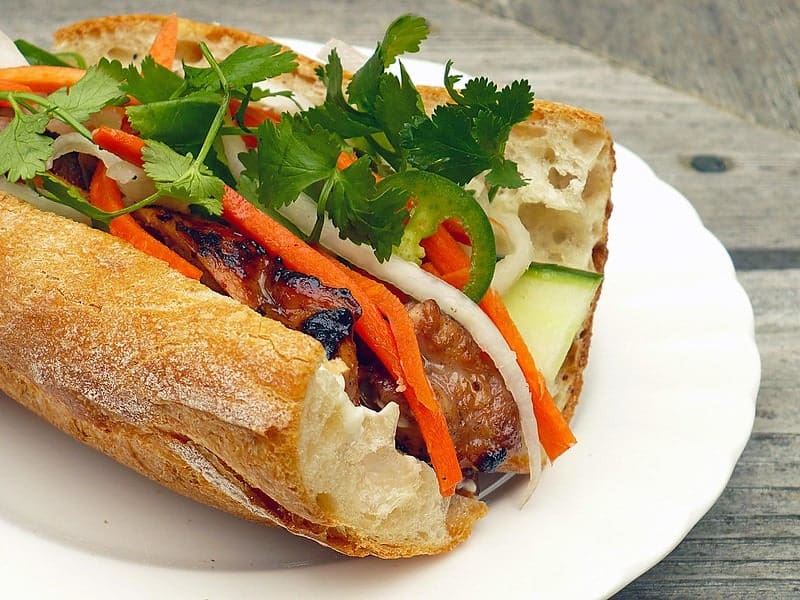
Flickr by: vtoanstar
For the exterior, Banh mi attracts tourists for its crispy yellow crust. Its fillings are full of layers of meat, the green and fresh herbs, the cucumbers, and carrots. Besides, the taste of Vietnamese Banh mi is the main attraction for diners. Banh mi is a blend of a crispy crust on the outside, the richness of inner meat, and the unique freshness of herbs and vegetables.
If you are a big fan of Banh mi, you can easily make Banh mi at home, following Vietnamese recipes. With an air fryer, you can create the bread that is crispy outside and soft inside. It would help if you considered the pros and cons of air fryer before making your perfect Banh mi with Vietnamese style.
In Vietnam, Banh mi appears almost everywhere, from the street trolleys to small roadside kiosks, even to restaurants. Besides the taste, Banh mi’s popularity is the suitability for all classes in society and all circumstances.
Banh mi can be a meal of a hard worker on the streets, and it can be a favorite of tourists coming to Vietnam and can be an expensive dish in a luxury restaurant. Thus, Banh mi has become the top selection of Vietnamese people every day. Coming to Vietnam, Banh mi should be one of the first dishes you must try.
3. Mi Quang (Quang noodle)
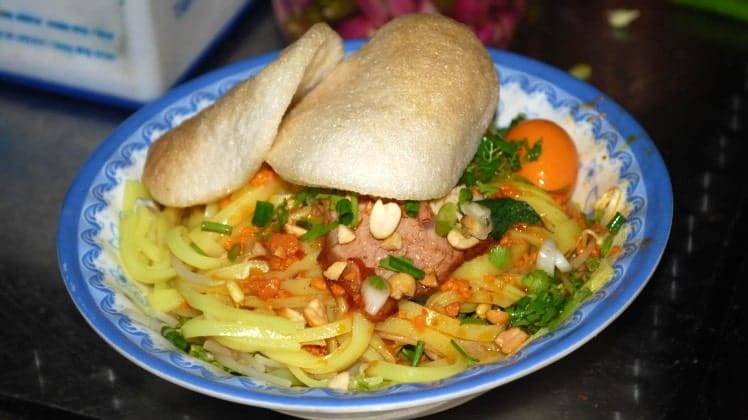
Returning to a small province in Vietnam, you will know the real richness of Mi Quang, a pride of Quang Nam people in Vietnam.
Mi Quang is white or yellow and made of rice flour. The Quang noodles are thicker and bigger than other noodles. The delicious noodles come from the delicious rice. The best rice Vietnamese people choose to make Mi Quang is Phu Chiem rice, which is soaked in the sun and wind in the Central of Vietnam.
Mi Quang’ filling includes pork, shrimp, and vegetables, sometimes toppings like eggs and beef slices. They are stir-fried with pineapple to create a slightly sour taste. The colors of toppings are required to be eye-catching and attractive before served.
Most importantly, the mystery of Mi Quang is its sauce, which determines if the whole bowl is good or bad. It is similar to the broth in Pho, but it is also different due to Quang land’s secret ingredient. In principle, Mi Quang is the mixed noodle, so the sauce must be savory in taste.
Moreover, Mi Quang tastes perfect only when coming with various herbs such as onion, coriander, mint leaves, cabbage, and so on. Indeed, what makes Mi Quang unique is the richness of the sauce and the noodles’ toppings. Tourists can enjoy the typical Mi Quang in Quang Nam or Hoi Nam.
4. Ruou Can (Can wine)
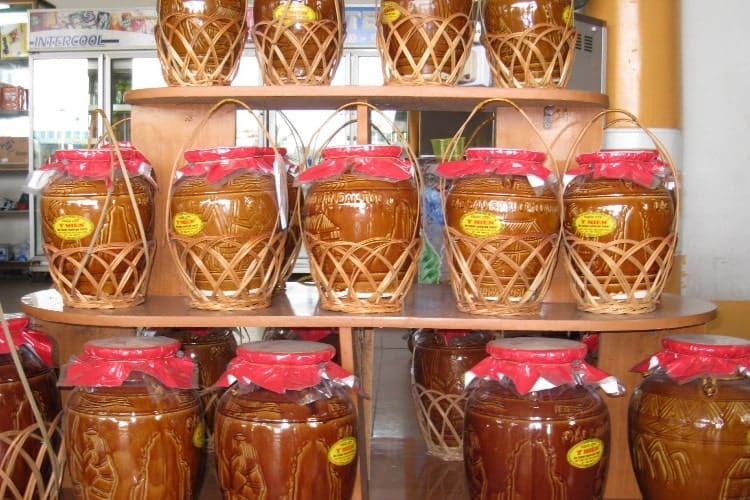
(by: wikipedia.org)
Ruou Can is a fermented wine from the mountainous areas of Tay Nguyen, Vietnam. Vietnamese people drink Ruou Can at their special celebrations or ceremonies. With the appealing aroma of the fresh leaves in the forest and the freshness of the young rice in the grainy period, Ruou Can has created a distinct flavor of their cuisine.
Ruou Can is brewed in cooked glutinous rice and some herbs in the local forest. The herbs they choose are diverse depending on ethnic group and area. Vietnamese then put them into a large jug and ferment for at least a month. Notably, the tubes are made of bamboo or pine. They are flamed through the fire and bent into a shape according to the curvature of the jug.
The taste of Ruou Can differs from other kinds of wine. It is slightly bitter and strong but delicious, and causes you to dizzy sometimes. Its sweet taste can attract you without any predictable consciousness. Visiting Tay Nguyen and trying Ruou Can could be a memorable experience, and if you are invited by the locals, which means you are seen as a special guest.
Ruou Can of Vietnamese people, Tay Nguyen people, in particular, has a distinct taste because it is the harmony of bitterness, sweetness, and spicy taste of their forest trees. When enjoying Ruou Can, you will feel the taste of the mountains and forests pouring in.
During the New Year, Ruou Can flavor becomes even more condensed in each sipping of wine. Anyone who has been to Vietnam, you should enjoy the characteristic flavor of the forests in Ruou Can.
5. Che Shan Tuyet (Shan Tuyet tea)
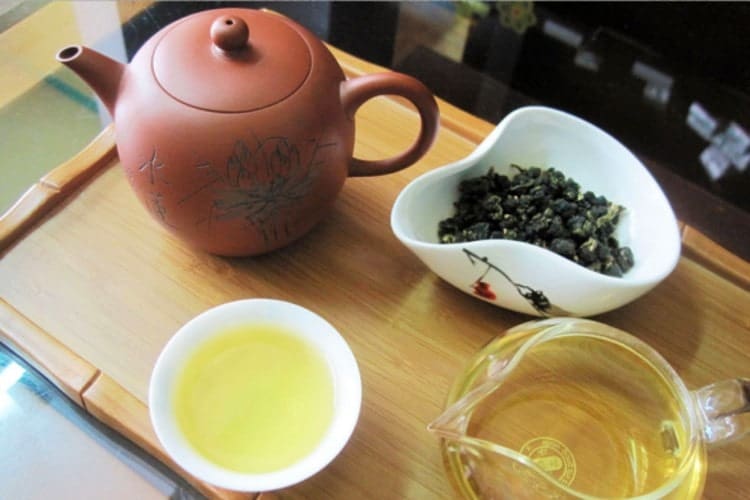
(by: trabacngon.com)
Anyone coming to visit Suoi Giang will be extremely impressed with lots of enormous San Tuyet trees with the moldy white color and thousands of branches. Traditional handcraft methods of Vietnamese people process Shan Tuyet tea.
The Shan Tuyet tea buds are collected from the old trees at the very high in the mountains. Shan Tuyet tea buds are big and white and gray. The tea leaves are covered with a smooth white fluff layer, so people often call it “Shan Tuyet – Snow tea”. When brewed, the tea has a golden color like honey, and its characteristic flavor is intensely sweet and bitter.
To make a warm pot of tea from the Shan Tuyet, Vietnamese people often use an old terracotta kettle and pure water in Giang river. Then they rinse them in the boiling water. After that, people pour the hot water in the pot so that the bubbles overflow outside. They cover the pot and water for about 10 minutes. Shan Tuyet tea is poured in two turns so that the cups have the same color and taste.
In the hot steam radiating with a fragrant aroma, sipping this charming tea, you will feel the tea’s delicate sweetness. The tea is not dense but has a bold taste instead. Shan Tuyet tea brings a strong taste and aroma to every cell, and leaves a great flavor lingering on your mouth. Shan Tuyet tea is truly a treasure in the majestic Hoang Lien Son mountain range of northern Vietnam.
Conclusion
Vietnamese cuisine is exceptionally diverse, from colors to flavor. Vietnamese food is rustic, simple, and rich in culture. Each dish represents the flavor of each region. Each food represents the Vietnamese people. If you are a chance to visit their dear Vietnam, don’t forget to enjoy their unique cuisine wherever you go. Visit our website for more travel tips and experiences, and hope you will surely have an unforgettable trip.
************************************
About The Author: I’m Tu (as always called Tino), I’m a blogger from Viet Nam. I’m also a father of a little, cute girl and an IT engineer, busy all day with numbers and machines. I often spend my free time listening to music, enjoying delicious food and entering in the kitchen to do housework where I have recently experimented with my new air fryer.
Website: https://www.dowhatuloves.com/
Twitter: https://twitter.com/MrTino52893510





